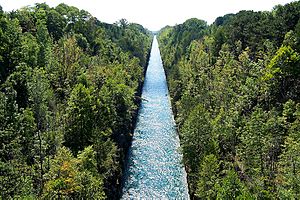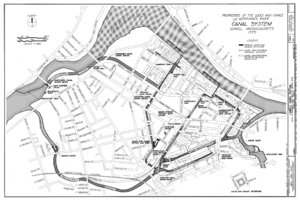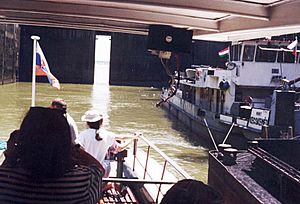Power canal facts for kids
A power canal is a special kind of canal built to create energy from water. Unlike canals used for boats, power canals are designed to move water to generate hydropower. This means they use the force of falling water to make electricity or power machines.
Power canals were very important during the Industrial Revolution in places like New England in the 1800s. They helped power factories and mills. Early power canals were often called mill races. They directly transferred power from water to machines in buildings. Later, these canals helped generate electricity for the same factories.
Over time, as electricity could be sent through power lines, many power canals were no longer needed. Some were filled in to make way for roads or city growth. While some were turned into local electric generators, most were closed. Today, you can still see the remains of power canals in old mill towns. Many are now protected as historical sites.
Contents
What is a Power Canal?
A power canal is a waterway built to direct water from a river or lake to a power station or factory. The water flows through the canal and then drops, turning turbines or water wheels. This movement creates energy. It's a way to harness the natural power of moving water.
How Power Canals Work
Imagine a river flowing downhill. A power canal diverts some of that water. It guides the water to a specific spot where it can fall a certain distance. As the water falls, it spins a large wheel or a turbine. This spinning motion is then used to power machinery directly or to create electricity. It's a clean way to get energy from nature.
Power Canals in History
Power canals played a huge role in the Industrial Revolution. Before modern electricity, factories needed a reliable source of power. Water was often the best option. By building canals, engineers could bring water power directly to new factories. This allowed towns to grow around these industrial centers.
The Rise of Mill Towns
Many towns, especially in the United States, grew up around power canals. These were called mill towns. Factories, particularly textile mills, used the power from the canals to run their machines. This led to many jobs and helped these towns become important industrial hubs. The canals were like the energy highways of their time.
Where Can We Find Power Canals Today?
Even though many power canals are no longer used for their original purpose, some still exist. Many have become historical landmarks. Others have been adapted to generate modern hydroelectric power. They remind us of a time when water power was key to industry.
Power Canals in the United States
Many states in the U.S. have historical power canals. They show the industrial past of the country.
- California
* California Powder Works (1864-1914)
- Maine
* Cumberland and Oxford Canal (1871-1905) – This canal was first used for transport.
- Massachusetts
* Holyoke Canal System (1827) * Merrimack Canal (1820s) * Lowell Power Canal System and Pawtucket Gatehouse (1821) * Turners Falls Canal (1869) – This canal also started as a transport canal.
- Michigan
* Edison Sault Power Canal
- New Hampshire
* Nashua power canal (1826), part of Mine Falls Park * Amoskeag Falls power canal – First dug for transport in 1807.
- New York
* Niagara Falls Hydraulic Power and Manufacturing Company (1862) * Rockland Mill Complex (c.1850)
- Ohio
* Great Western Powder Works (1877)
Power Canals in New Zealand
New Zealand also uses canals for power generation, especially for hydroelectric dams.
- Tekapo Canal
- Pukaki Canal
- Ohau Canal




